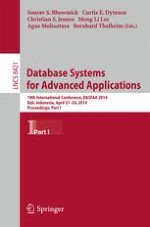These two volumes set LNCS 8421 and LNCS 8422 constitutes the refereed proceedings of the 19th International Conference on Database Systems for Advanced Applications, DASFAA 2014, held in Bali, Indonesia, in April 2014. The 62 revised full papers presented together with 1 extended abstract paper, 4 industrial papers, 6 demo presentations, 3 tutorials and 1 panel paper were carefully reviewed and selected from a total of 257 submissions. The papers cover the following topics: big data management, indexing and query processing, graph data management, spatio-temporal data management, database for emerging hardware, data mining, probabilistic and uncertain data management, web and social data management, security, privacy and trust, keyword search, data stream management and data quality.
